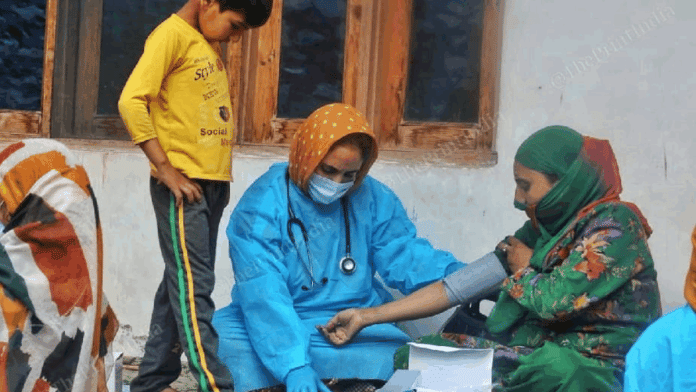New Delhi: On average, a whopping 49.5 percent of Indian men and 36.8 percent of women with hypertension—a risk factor for various life-threatening diseases, often called a silent killer—don’t have the disease under control despite taking medication, a secondary analysis of the National Family Health Survey (NFHS) 5 data has found.
The analysis of the data carried out by researchers from several key institutions, including the Mumbai-based Indian Institute of Population Sciences and Post Graduate Institute of Medical Education and Research (PGIMER), Chandigarh, India identified alcohol consumption, indoor air pollution and high body mass index (BMI) as main behavioural characteristics associated with uncontrolled hypertension among both men and women.
The findings from the research were published under the title ‘Unhealthy behaviours associated with uncontrolled hypertension among adults in India- Insights from a national survey’ in the US-based PLOS One journal on 17 January. NFHS 5 was undertaken by the Union Health Ministry between 2019 and 2021.
Hypertension is a major cause of cardiovascular diseases, the cause of 17.9 million or 31 percent of all global deaths, according to the World Health Organization (WHO).
According to the Global Burden of Disease 2019, a report by the Institute for Health Metrics and Evaluation (IHME), an estimated 19 percent of global deaths were attributable to elevated blood pressure that year.
The WHO describes hypertension or high blood pressure as the condition when the pressure in the blood vessels is too high—140 mm HG (millimetres of mercury) systolic pressure and 90 mm HG diastolic pressure, or higher.
Systolic pressure is the pressure created as blood pumps out of the heart and into the arteries, while the diastolic pressure is the pressure created as the heart rests between heartbeats. Normal blood pressure is less than 120/80 mm HG.
The study published in PLOS One called the very high prevalence of uncontrolled hypertension as a “cause of concern”.
“Tobacco usage, alcohol consumption, obesity, indoor air pollution, and the presence of comorbid conditions should be given utmost priority during patient management,” Sonu Goel, lead author of the study and a professor of community medicine at PGIMER told ThePrint.
For managing the condition, emphasis should be placed on the importance of adhering to the medication and lifestyle modifications. While managing a population, the focus should be on targeting significant unhealthy behaviours, he stressed.
Also Read: Why a govt-appointed panel has recommended a complete ban on popular painkiller nimesulide
A silent killer
Experts have termed hypertension a silent killer because it rarely presents any observable symptoms till the onset of a severe medical crisis, such as heart attack, stroke, or chronic kidney disease.
Keeping track of blood pressure is the only way to detect hypertension.
In India, hypertension is a significant cause of mortality and disability. According to the Indian Council of Medical Research–India Diabetes (ICMR-INDIAB) study, the largest epidemiological study of various non-communicable diseases in India, published in 2023, found that an estimated 315 million Indians, or 35.5 percent of the population, had hypertension.
The study, conducted by the ICMR and the Madras Diabetes Research Organisation, also highlighted a great regional variation in the disease with 51.8 percent of people in Punjab suffering from hypertension as compared to 24.3 percent in Meghalaya.
However, the rate of controlled hypertension in the country has also been very low. Experts also say that lowering blood pressure to target levels is crucial for preventing cardiovascular issues in hypertensive patients, with multiple medications often required to achieve this.
What the report said
The 17 January analysis said there was a significant difference in the proportion of uncontrolled hypertension among urban males (51 percent) and rural males (48 percent). Similarly, there was a substantial difference in the proportion of uncontrolled hypertension among urban females (41 percent) and rural females (34 percent).
It also found that the prevalence of uncontrolled hypertension increased in parallel with the wealth index, from poorest to richest, among both males and females.
Over 50 percent of uncontrolled hypertension in men was observed in Punjab and Uttarakhand from the northern region, Arunachal Pradesh, Assam, Nagaland, and Manipur from the north-eastern region, Odisha and Sikkim from the eastern region, Madhya Pradesh and Chhattisgarh from the central region.
Among females, more than 50 percent prevalence of uncontrolled hypertension was only observed in Nagaland.
Researchers noted that “higher age groups, widowed/divorced/separated individuals, people with more than secondary level education, currently working population, people residing in urban areas, and those belonging to richer wealth quintiles were observed to have significantly higher proportions of uncontrolled hypertension in the present study”.
They also found that a higher proportion of uncontrolled hypertension was observed among people with diabetes and obesity in both males and females.
On the other hand, non-users of tobacco among females and alcohol users among males had significantly higher uncontrolled hypertension. The data also supported “limiting alcohol consumption” for lowering its chances.
Among women, level of education (decreased with increasing educational levels), use of tobacco, and health insurance coverage (higher uncontrolled hypertension among those with higher coverage) were among other significant factors, while employment (higher proportion of uncontrolled hypertension among the working population) was a factor for men.
“Effective policies should emphasise comprehensive prevention strategies, including public education on lifestyle modifications and regular blood pressure screenings,” said the researchers.
Integrating hypertension management into broader healthcare policies can improve overall health outcomes and reduce the incidence of comorbid conditions and additionally, ensuring equitable access to affordable medications and healthcare services can alleviate long-term healthcare costs, they added.
(Edited by Sanya Mathur)
Also Read: 2nd ‘living drug’ against blood cancer gets regulatory nod. All about Qartemi, made in India






